The Supreme Court is poised to release its decision on the fate of President Joe Biden's student loan forgiveness plan.
Biden's plan, announced last summer, would cancel up to $10,000 in federal student loan debt for those making less than $125,000 or households with less than $250,000 in income per year. Pell Grant recipients, who typically demonstrate more financial need, would have an additional $10,000 in debt forgiven.
The court is weighing two challenges to the plan, one from six Republican-led states and the other involving a lawsuit filed by two students.
Millions are eagerly waiting to find out if the court will allow the plan to take effect. Some 43 million borrowers stand to benefit, and 20 million could have their debt completely wiped away, according to the Biden administration.
The Supreme Court will release its next round of opinions at 10 a.m. ET on Thursday.

Here's what to look out for in the Supreme Court's decision in Biden v. Nebraska and Department of Education v. Brown.
Did the Biden Administration Exceed Its Authority?
The Biden administration relied on the Higher Education Relief Opportunities for Students Act, commonly known as the HEROES Act, to cancel student loan debt. The law was enacted in response to the military conflicts in Iraq and Afghanistan.
During oral arguments, the court's conservative justices suggested the Biden administration had exceeded its authority with the plan. The Republican states that sued have argued that Congress needed to first approve the debt relief before it was set in motion.
Solicitor General Elizabeth Prelogar argued that the debt relief was in the scope of Biden's authority under the HEROES Act due to the national emergency created by the COVID-19 pandemic.
Do the Challengers Have Standing?
The court is also considering whether the Republican-controlled states and two students who challenged the plan have the legal right, or standing, to sue. Parties generally have to show they would suffer financial harm in order to have standing in such cases.
When the court heard oral arguments in February, some liberal justices expressed skepticism about whether plaintiffs in both cases had met the legal threshold—known as standing—of showing they would be harmed by the program.
Although the high court is dominated 6-3 by conservatives, there is a chance the justices could decide the challengers do not have the right to sue and allow the plan to go into effect.
Will the Justices Be Divided in Their Ruling?
The last opinions to be released before the justices begin their summer break typically cover some of the most contentious issues the court has wrestled with in its term.
A divided ruling would not be a surprise. During oral arguments, the court's conservative justices appeared ready to sink Biden's plan.
They questioned the cost of the program as among the reasons why it should have been approved by Congress. Meanwhile, members of the court's liberal wing expressed concern for borrowers who would struggle if relief isn't granted.








